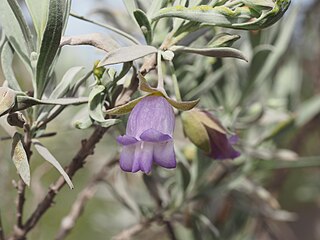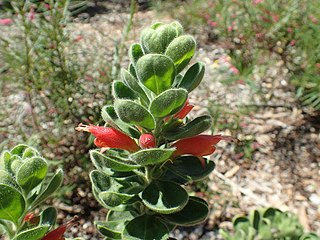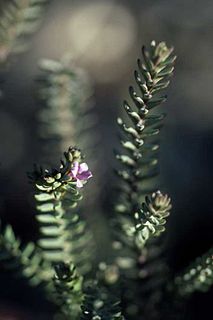
Eremophila youngii is a flowering plant in the figwort family, Scrophulariaceae and is endemic to Western Australia. It is a dense, erect shrub with many of its parts covered with a layer of grey to yellowish-grey scales and with pink, purple or red flowers.

Eremophila hygrophana is a flowering plant in the figwort family, Scrophulariaceae and is endemic to Australia. It is an erect, compact shrub with crowded, grey leaves and violet to purple flowers and is native to South Australia and Western Australia.

Eremophila maitlandii, commonly known as Shark Bay poverty bush, is a flowering plant in the figwort family, Scrophulariaceae and is endemic to Western Australia. It is a silvery-grey shrub with linear leaves and lilac-coloured to light purple flowers and is common in coastal areas between Shark Bay and Carnarvon.
Eremophila compacta, commonly known as compact poverty bush, is a flowering plant in the figwort family, Scrophulariaceae and is endemic to the central west of Western Australia. There are two distinct subspecies differing in their growth habit but both have grey leaves due to a covering of white or grey hairs, and purple to blue, rarely white flowers.

Eremophila glandulifera is a flowering plant in the figwort family, Scrophulariaceae and is endemic to Western Australia. It is a small shrub with hairy, grey foliage and attractive deep pink to red flowers usually growing in mulga woodland.
Eremophila grandiflora is a flowering plant in the figwort family, Scrophulariaceae and is endemic to Western Australia. It is a large shrub with shiny leaves and the largest flowers in its genus and is only known from a restricted area near Paynes Find.

Eremophila granitica, commonly known as granite poverty bush and thin-leaved poverty bush is a flowering plant in the figwort family, Scrophulariaceae and is endemic to Western Australia. It is an erect, open shrub with sticky, narrow leaves and with lilac-coloured flowers.

Eremophila homoplastica is a flowering plant in the figwort family, Scrophulariaceae and is endemic to Western Australia. It is a small shrub with many fine, tangled branches, tiny leaves and purple to lilac-coloured flowers.

Eremophila interstans is a flowering plant in the figwort family, Scrophulariaceae and is endemic to Australia. It is a shrub or small tree found in Western Australia and South Australia and has narrow leaves with a hooked end, and white or cream-coloured flowers.

Eremophila jucunda is a flowering plant in the figwort family, Scrophulariaceae and is endemic to Western Australia. It is a small to medium-sized shrub with hairy branches and leaves, lance-shaped to egg-shaped leaves and cream-coloured, lilac or purple flowers.
Eremophila macmillaniana, commonly known as grey turpentine bush, is a flowering plant in the figwort family, Scrophulariaceae and is endemic to Western Australia. It is an erect shrub with broad, grey leaves and cream-coloured or pink flowers with red or purple spots on the outside.

Eremophila margarethae, commonly known as sandbank poverty bush, is a flowering plant in the figwort family, Scrophulariaceae and is endemic to Western Australia. It is a low, spreading shrub with grey leaves, flowers a shade of pink or purple, common in central areas of Western Australia.
Eremophila metallicorum, commonly known as miners poverty bush, is a flowering plant in the figwort family, Scrophulariaceae and is endemic to Western Australia. It is a small shrub with narrow leaves and lilac-coloured flowers on an S-shaped stalk.

Eremophila muelleriana, commonly known as round-leaved eremophila, is a flowering plant in the figwort family, Scrophulariaceae and is endemic to Western Australia. It is an open shrub with light-coloured new foliage, broad leaves and deep purple-violet flowers.

Eremophila pantonii, commonly known as broombush, is a flowering plant in the figwort family, Scrophulariaceae and is endemic to Western Australia. It is a broom-shaped shrub with narrow leaves which have a hooked tip, and blue or purple, sometimes white flowers in winter and spring.

Eremophila purpurascens, commonly known as purple eremophila, is a flowering plant in the figwort family, Scrophulariaceae and is endemic to Western Australia. It is an erect, bushy shrub with warty leaves and spotted, pink to red flowers.
Eremophila shonae is a flowering plant in the figwort family, Scrophulariaceae and is endemic to Western Australia. It is an erect shrub or a low spreading shrub, depending on subspecies and has very sticky branches and leaves due to the presence of large amounts of resin. The leaves are narrow and the flowers are mauve to purple and white inside with purple spots.

Eremophila spathulata, commonly known as spoon-leaved eremophila, is a flowering plant in the figwort family, Scrophulariaceae and is endemic to Western Australia. It is a shrub with many tangled branches, stiff, grey, spoon-shaped leaves, reddish-purple sepals and blue, pink or violet petals.

Eremophila splendens is a flowering plant in the figwort family, Scrophulariaceae and is endemic to Western Australia. It is a shrub which is mostly covered with a layer of glandular hairs and has red, unspotted flowers.

Eremophila veronica, commonly known as veronica-like eremophila, is a flowering plant in the figwort family, Scrophulariaceae and is endemic to Western Australia. It is a low, spreading shrub with small, crowded leaves and lilac-coloured flowers which have a short petal tube and spreading petal lobes.















